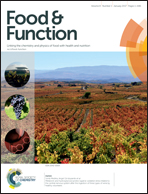The kinetics and mechanism of α-glucosidase inhibition by F5-SP, a novel compound derived from sericin peptides
Abstract
The inhibition of α-glucosidase decreases postprandial blood glucose and therefore plays an important role in the treatment of type 2 diabetes mellitus. The present study investigated and characterized a peptide fraction of sericin hydrolysate, the kinetics of peptide-induced inhibition of α-glucosidase, and the interaction mechanism between the peptides and α-glucosidase. The fraction that eluted with 0.4 M NaCl (F5-SPs) on a DEAE-cellulose column exhibited significant inhibitory activity with an IC50 of 41 ± 1.94 μg mL−1. A kinetics analysis revealed that the F5-SP-induced inhibition was a reversible and parabolic mixed-type inhibition with a Ki value of 86.63 ± 0.014 μg mL−1. F5-SPs can bind to α-glucosidase at multiple sites to alter the conformation of α-glucosidase. F5-SPs were found to be rich in Gly, Ser, Glu, Tyr, Arg, and Pro, and had a sericin-conserved sequence SEDSSEVDIDLGNLG, as analyzed by Nano LC-MS/MS. Fluorescence spectra analysis showed that F5-SPs quenched the intrinsic fluorescence of α-glucosidase by a static quenching mechanism, and circular dichroism analysis suggested that the binding of F5-SPs to α-glucosidase resulted in the alteration of the secondary structure of an enzyme. The results of this study support the dietary recommendation of F5-SPs for the treatment of type 2 diabetes.


 Please wait while we load your content...
Please wait while we load your content...